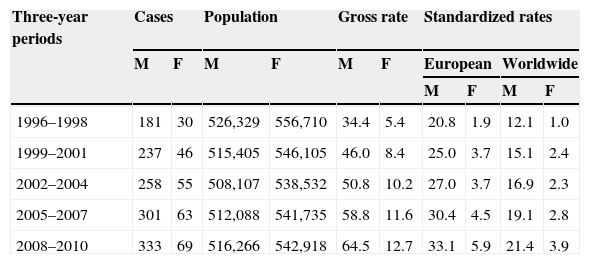Spain is a country where bladder cancer incidence and mortality rates are some of the highest in the world. The aim of this study is to know the incidence, trends and geographical distribution of bladder cancer in the health area of León.
Material and methodsThe new cases of bladder cancer (CIE-188) in patients residing in the health area of León and registered in the Hospital Tumor Registry of the Centro Asistencial Universitario in León (Spain) between 1996 and 2010 were included in this study. Triennial crude incidence and adjusted incidence rates to the worldwide and European population were calculated. Population data of the municipalities of Leon (Spain) were obtained from National Institute of Statistic of Spain (INE, Instituto Nacional de Estadística). Data were disaggregated by sex-groups and five-year age groups. Spatial distribution of smoothed municipal relative risks (RR) of bladder cancer was carried out using a Besag, York and Mollié model. Bayesian model were used to calculate the posterior probability (PP) of RR>1.
Results1573 cases were included. Incidence rates standardized to European population increased among men from 20.8/100,000 (1996–98) to 33.1/100,000 (2006–2008) and among women these rates increased from 1.9/100,000 to 5.9/100,000 for the same period of time. No relevant differences were found in the municipal distribution of the incidences.
ConclusionsBladder cancer incidence rates are high in the European context. Rising trends in incidence in both sexes, particularly in women are observed.
España presenta unas de las tasas más elevadas de incidencia y mortalidad por cáncer de vejiga del mundo. El presente estudio tiene por objeto conocer la incidencia, tendencia y distribución geográfica del cáncer de vejiga en el área de salud de León.
Material y métodosFueron incluidos los casos nuevos de cáncer de vejiga (CIE-188) del registro hospitalario de tumores del Centro Asistencial Universitario de León, entre 1996–2010 con residencia en el ASL. Se calcularon las incidencias brutas trienales y ajustadas a población mundial y europea. Como denominador se utilizaron los datos del INE de población desagregada por sexo y grupos quinquenales de edad de residentes en municipios del ASL. Para el análisis de la distribución espacial se estimaron los riesgos relativos (RR) municipales suavizados mediante el ajuste del modelo de Besag, York y Mollié y sus probabilidades posteriores de que los RR fuesen>1 (PP), utilizando métodos bayesianos.
ResultadosSe incluyeron 1.573 casos. Las tasas estandarizadas a población europea ascendieron de 20,8 (1996–98) a 33,1 (2006–2008) casos nuevos por 100.000 hombres y de 1,9 a 5,9 en las mujeres. No se observaron diferencias de interés en la distribución municipal de las incidencias.
ConclusionesLas tasas de incidencia observadas son elevadas en el contexto europeo. Se observan tendencias ascendentes en hombres y especialmente relevantes en mujeres.











